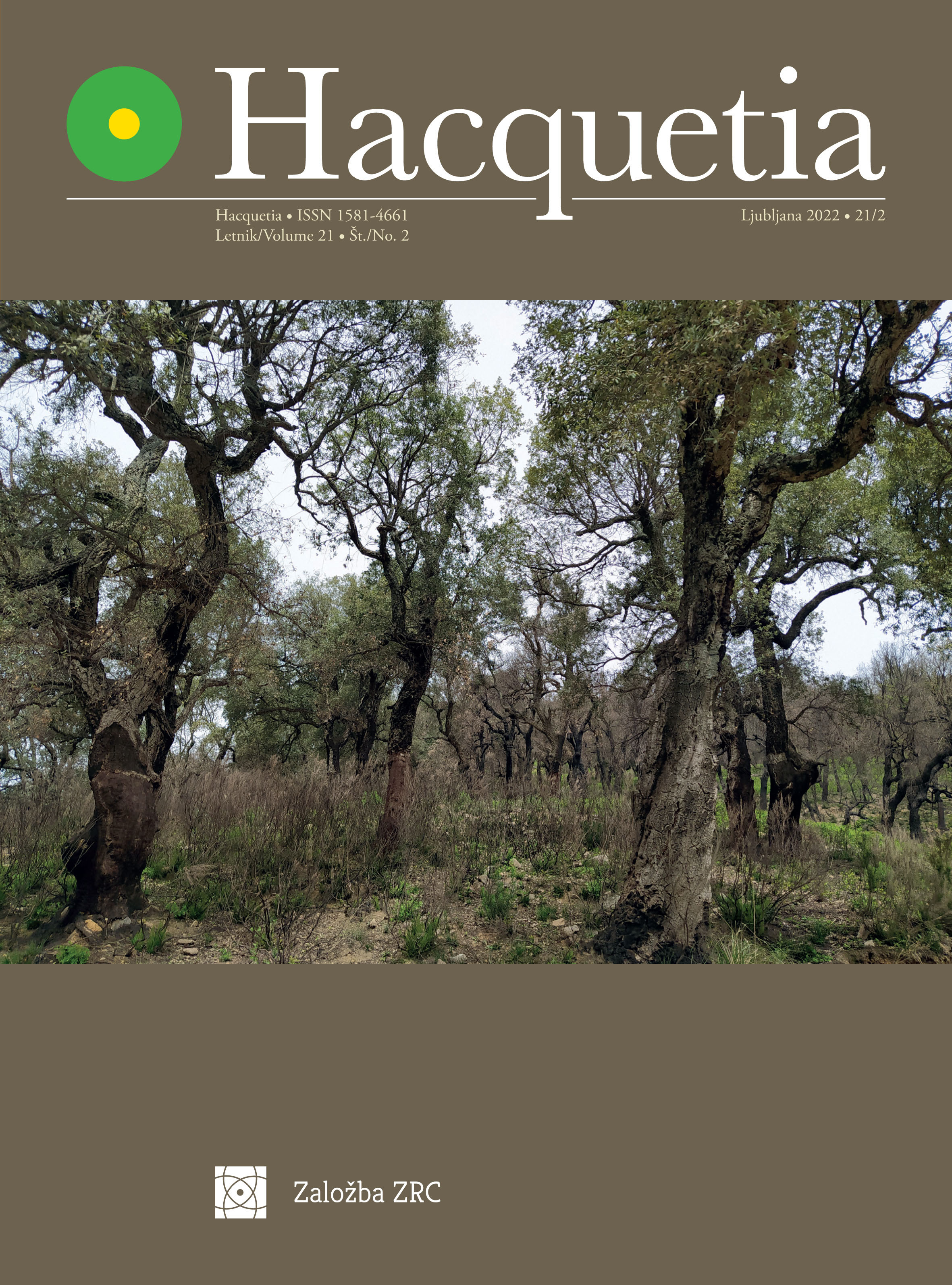Muscari baeticum (Scilloideae, Asparagaceae), a new addition to the native flora of Tunisia and third report to Mediterranean Africa
DOI:
https://doi.org/10.2478/hacq-2022-0002Ključne besede:
Asparagales, Muscari subg. Botryantus, korologija, nova najdbaPovzetek
Muscari baeticum, ki izvira iz Španije, je tu na novo zabeležen iz središča vzhodno Tunizije, doslej neznanega iz severozahodne obale Sredozemlja. Podan je opis vrste in prvi podatki o njeni ekologiji v Severni Afriki ter diagnostične značilnosti sorodnih vrst. Predstavljeni so geografska razširjenost, ocena IUCN, grožnje in nekateri ukrepi za ohranjanje ex situ. Na voljo so tudi fotografske ilustracije in ključ do vrste Muscari v Tuniziji.
Prenosi
Literatura
APD. (n.d.). African Plant Database (version 3.4.0). Conservatoire et Jardin botaniques de la Ville de Genève, South African National Biodiversity Institute. Retrieved October 25, 2021, from http://www.ville-ge.ch/musinfo/bd/cjb/africa/index.php.
Byng, J. W. (2014). The Flowering Plants Handbook: A practical guide to families and genera of the world. Plant Gateway Ltd.
Cuénod, A., Pottier-Alapetite, G., & Labbé, A. (1954). Flore analytique et synoptique de la Tunisie (Cryptogames Vasculaires, Gymnospermes et Monocotylédones). Office de l'expérimentation et de la vulgarisation agricole de Tunisie.
Davis, P. H., & Stuart, D. C. (1980). Muscari Mill. In T. G., Tutin, V. H., Heywood, & D. H., Valentine (Eds.), Flora Europaea 5. Cambridge University Press.
Dobignard, A., & Chatelain, C. (2010). Index synonymique flore d’Afrique du Nord. Vol. 1 : Pteridophyta, Gymnospermae et Monocotyledoneae. Editions Des Conservatoire et Jardin Botaniques.
Eker, I., & Yildrim, H. (2021). Muscari inundatum (Asparagaceae, Scilloideae), a new species from southern Anatolia. Phytotaxa, 484(2), 181–194. https://doi.org/10.11646/phytotaxa.484.2.3
Engler, A. (1887). Liliaceae. In A. Engler, & K. Prantl (Eds.), Die Natürlichen Pflanzenfamilien 2(5) (pp. 10–91). W. Engelmann.
Fennane, M., Ibn Tattou, M., & El Oualidi, J. (2014). Flore pratique du Maroc, Manuel de détermination des plantes vasculaires, Vol. 3, Dicotylédones (p.p.), Monocotylédones. Institut Scientifique, Service d'édition.
Garbari, F., & Greuter, W. (1970). On the taxonomy and typification of Muscari Miller (Liliaceae) and allied genera, and on the typification of generic names. Taxon, 19, 329–335. https://doi.org/10.2307/1219056
GBIF [Global Biodiversity Information Facility]. (n.d.). Muscari baeticum Blanca, Ruíz Rejón & Suár.-Sant. Reteieved January 23, 2022, from https://www.gbif.org/species/2772213.
Jafari, A., & Maassoumi, A. A. (2011). Synopsis of Leopoldia, Muscari and Pseudomuscari (Hyacinthaceae) in Iran, with Leopoldia ghouschtchiensis sp. nova. Annales Botanici Fennici, 48, 396–400.
Jafri, S. M. H., & El-Gadi, A. (Eds.) (1978). Flora of Libya 57. Al-Fateh University.
Kubitzki, K. (1998). The families and genera of vascular plants III: Flowering Plants-monocotyledons Lilianae (except Orchidaceae). Springer-Verlag Berlin.
Miller, P. (1754). The Gardeners Dictionary (4th ed.).
Quézel, P., & Santa, S. (1962). Nouvelle flore de l’Algérie et des régions désertiques méridionales (Vol. 1). CNRS.
Rechinger, K. (1990). Liliaceae II. In K. H., Browicz, K. Persson, & P. Wendelbo (Eds.), Flora Iranica 165 (pp. 140–148). Akademic Druck.
Suárez Santiago, V. N., & Blanca G. (2013). Muscari Mill. In E. Rico, et al. (Eds.), Flora Iberica 20 (pp. 171–184). CSIC.
Suárez-Santiago V. N., Salinas M. J., Romero-García A. T., Garrido-Ramos M. A., De La Herrán R., Ruiz-Rejón C., Ruiz-Rejón M., & Blanca, G. (2007). Polyploidy, the Major Speciation Mechanism in Muscari Subgenus Botryanthus in the Iberian Peninsula. Taxon, 56(4), 1171–1184. https://doi.org/10.2307/25065910
Thiers, B. (2021, October 25). Index Herbariorum, a global directory of public herbaria and associated staff. New York Botanical Garden’s Virtual Herbarium. http://sweetgum.nybg.org/ih/.
WCSP (n.d.). World Checklist of Selected Plant Families. Facilitated by the Royal Botanic Gardens, Kew. Retrieved October 25, 2021, from http://wcsp.science.kew.org/
Yıldırım, H. (2015). Muscari atillae sp. nova (Asparagaceae): a new species from eastern Anatolia, Turkey. Phytotaxa, 213, 291–295. https://doi.org/10.11646/phytotaxa.213.3.9
Yıldırım, H. (2016). Muscari elmasii sp. nova (Asparagaceae): a new species from western Anatolia, Turkey. Turkish Journal of Botany, 40, 380–387. https://doi.org/10.3906/bot-1507-1517
Yıldırımli, Ş., & Kılıç, Ö. (2019). A new species of Muscari Mill. (Asparagaceae/Liliaceae), M. nazimiyensis from Tunceli, Turkey. Ot Sistematik Botanik Dergisi, 26, 13–16.
Prenosi
Objavljeno
Kako citirati
Številka
Rubrike
Licenca
Avtorske pravice (c) 2022 ZRC-SAZU

To delo je licencirano pod Creative Commons Priznanje avtorstva-Nekomercialno-Brez predelav 4.0 mednarodno licenco.
Avtorji jamčijo, da je delo njihova avtorska stvaritev, da v njem niso kršene avtorske pravice tretjih oseb ali kake druge pravice. V primeru zahtevkov tretjih oseb se avtorji zavezujejo, da bodo varovali interese založnika ter da bodo povrnili morebitno škodo.
Podrobneje v rubriki: Prispevki













